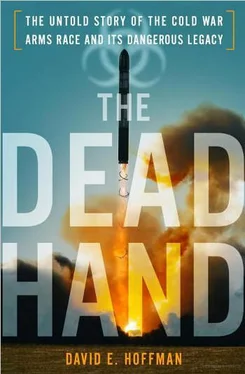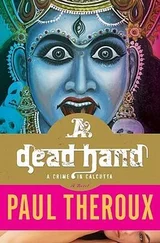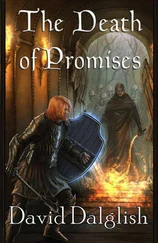The rods, pumps and gears used to control and moderate the nuclear fission inside the Chernobyl reactor were dependent on electricity. If outside power were suddenly cut off, it would take forty seconds to kickstart auxiliary diesel engines. Without power for forty seconds, however, the pumps would not force water through the reactor, which would quickly overheat. This forty-second gap was something that Soviet designers knew about and worried over; they were still trying to fix it. On the night of April 26, an improvised work-around was being tested. The operators knew that after a power outage, the spinning turbine blades would keep rotating under their own momentum. So they reasoned: why not use the still-spinning blades to generate enough power to keep the water pumps going for forty seconds? The goal of the test was to see how much power the rotating blades could generate, but the duty operators were ill prepared and the reactor design badly flawed.
One operator, arriving at his station, was confused by the logbook. He called someone else to inquire.
“What shall I do?” he asked. “In the program there are instructions of what to do, and then a lot of things crossed out.”
The other person thought for a minute, then replied, “Follow the crossed out instructions.” 22
After midnight Saturday, the reactor was powered down to very low levels for the test. Then, apparently because power was too low, the operators tried to power it up again, perhaps too quickly. Nuclear fission creates by-products that must be allowed to dissipate before the reactor is powered up again, but this danger was ignored.
As they powered up the reactor, a chain reaction began to spin out of control.
A foreman who entered the reactor hall at about 1:23 A.M. saw an unforgettable sight. The reactor had a massive lid. It was the “upper biological shield,” intended to prevent radiation exposure to workers during routine operations. The lid was a circle forty-nine feet in diameter, consisting of cubes, each sitting on top of a channel. When the foreman looked down, he saw the 770-pound cubes start to rumble and dance on top of the channels, “as if one thousand seven hundred people were tossing their hats into the air.” 23
The operators hit the red panic button, marked “AZ,” for the emergency power reduction system. But it was too late. They desperately tried to lower the control rods to stop the fission, but the rods, by some accounts, got stuck, perhaps because the holes in the core had warped. Also, there was a design flaw in the rods, which had a section of water and graphite at each end known as the displacer, while the absorber was in the middle. When the rods got stuck, the absorber didn’t make it far enough down into the core to be useful in moderating the fission. Moreover, the rods also may have forced water out from the channels, increasing the heat and steam. In the RBMK-1000 reactor design, excessive steam caused the nuclear chain reaction to accelerate. As the heat inside the graphite core skyrocketed, more of the water then turned to steam, which caused the reactor to get even hotter. More steam, more heat, and the reactor went out of control.
At 1:23 A.M., two explosions rocked Chernobyl. These were extremely powerful, caused by the chain reaction generating huge amounts of heat and pressure. The reactor blew apart, and the explosions were followed by fire. The blast blew a hole straight upward through the roof of Reactor No. 4. The weighty lid was tossed aside like a cocked hat, and radioactive materials—gases, graphite and bits of broken fuel rods—were thrust into the atmosphere. Some debris fell down near the site. Radioactive elements were carried by the winds across Europe. The initial contamination was one nightmare, then came another: the graphite core was on fire and burned for ten days, spewing more dangerous materials into the air.
Hours after the disaster, with the graphite core burning, an “urgent report” arrived at the Central Committee in Moscow from Deputy Energy Minister Alexei Makukhin, who had once been minister of energy in the Ukraine when Chernobyl was first being built. The report said that at 1:21 A.M. on April 26 an explosion occurred in the upper part of the reactor, causing fire damage and destroying part of the roof. “At 3:30, the fire was extinguished.” Personnel at the plant were taking “measures to cool the active zone of the reactor.” No evacuation of the population was necessary, the report said.
Almost everything in Makukhin’s report was wrong. The reactor was still burning and was not being cooled, and the population should have been evacuated immediately. What the report did not say was even worse: at the scene, radiation detectors failed, firefighters and others were sent in without adequate protection and officials were debating—but not deciding—about evacuation. 24
Gorbachev recalled many years later that he first heard of the disaster in a phone call at 5 A.M., but he insisted he did not learn until the evening of April 26 that the reactor had actually exploded and there had been a huge discharge into the atmosphere. “Nobody had any idea that we were facing a major nuclear disaster,” he recalled. “Quite simply, in the beginning even the top experts did not realize the gravity of the situation.” 25Chernyaev, who was at Gorbachev’s side throughout the crisis, recalled that “even our top leadership did not fully realize the difficulties and dangers associated with nuclear energy.” He acknowledged that “one can blame Gorbachev for trusting those responsible,” but added, “since nuclear energy was directly linked to the military-industrial complex, it was taken for granted that everything was in perfect order. And that there was no chance of a ‘surprise’ like Chernobyl.” 26
The reason for the lack of information was the Soviet system itself, which reflexively buried the truth. At each level of authority, lies were passed up and down the chain; the population was left in the dark; and scapegoats were found. Gorbachev was at the top of this decrepit system; his biggest failure was that he did not break through the pattern of cover-up right away. He reacted slowly, a moment of paralysis for this man of action. He seemed unable to get the truth when he needed it from the disaster scene or the officials responsible for nuclear power. While Gorbachev’s personal charisma had sparked excitement on the streets of Leningrad the year before, he did not appear in public for eighteen days after the explosion. While he disdained the secrecy of the military, he was just as silent before his own people and much of Europe in a situation of real peril. Gorbachev, who in January called for the elimination of all nuclear weapons, suddenly was faced with a real-time, catastrophic example of what the world might be like after a nuclear explosion, and it was even more frightening than he could have guessed.
Without a containment shelter, radioactive isotopes soared into the atmosphere. Winds carried the contamination north, and by Sunday, radiation was detected in Sweden at the Forsmark nuclear power station, one hundred miles north of Stockholm. The Swedes confronted the Soviets at midday Monday, April 28. Gorbachev had assembled an emergency Politburo meeting at 11 A.M., but the Kremlin had not said a word about the accident, at home or abroad. In notes from the emergency meeting, aides to Gorbachev wrote: “The information was alarming but scant.” 27According to Volkogonov, the historian, as the Politburo discussed how to handle the accident, Gorbachev said, “We must issue an announcement as soon as possible, we must not delay…” Alexander Yakovlev also said, “The quicker we announce it, the better it’ll be…” Other accounts suggest some Politburo members wanted to keep silent. 28The announcement was delayed for hours and hours. But people with radios that could pick up foreign broadcasts in Moscow already knew something truly horrible had happened; the reports were alarming.
Читать дальше












